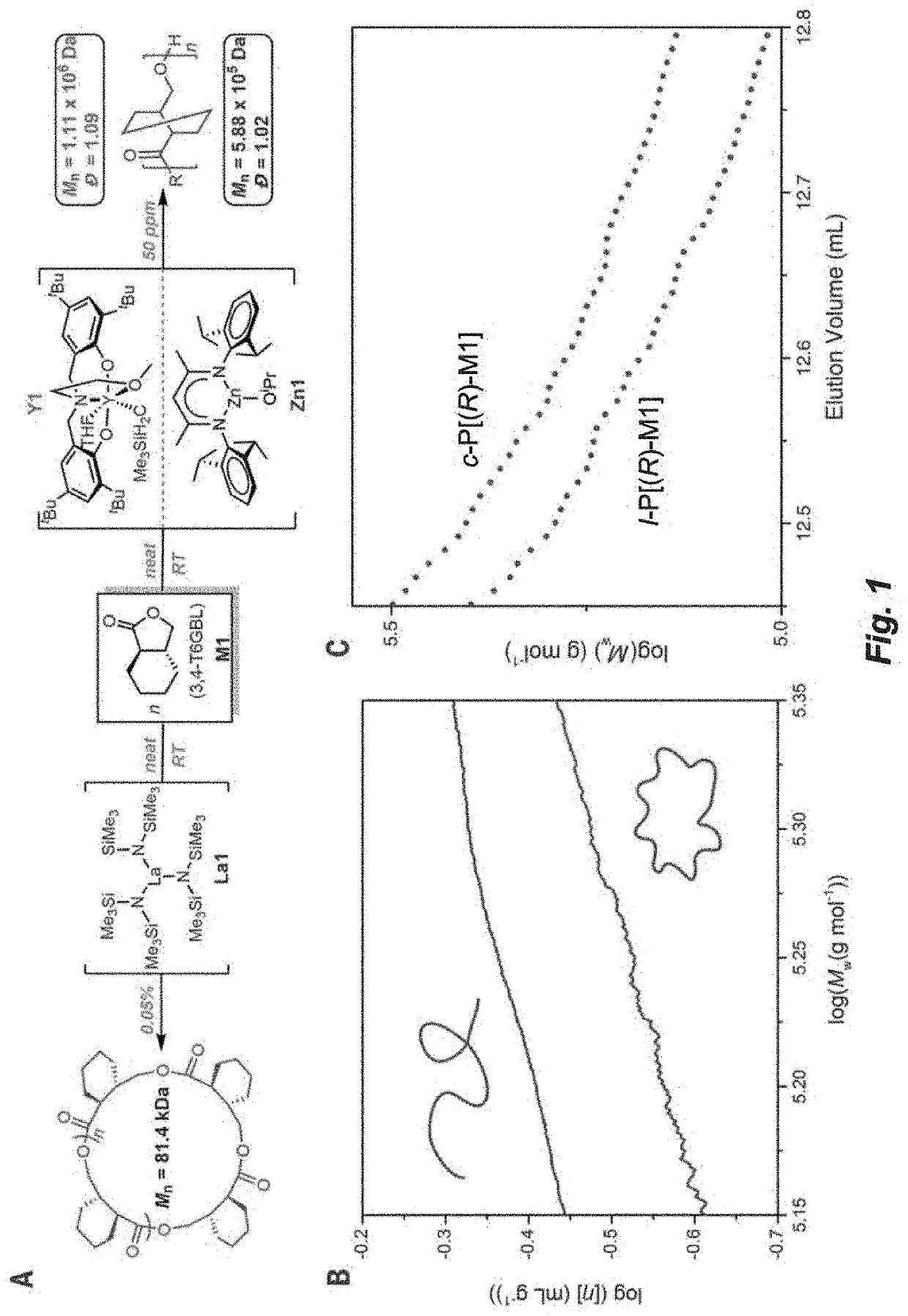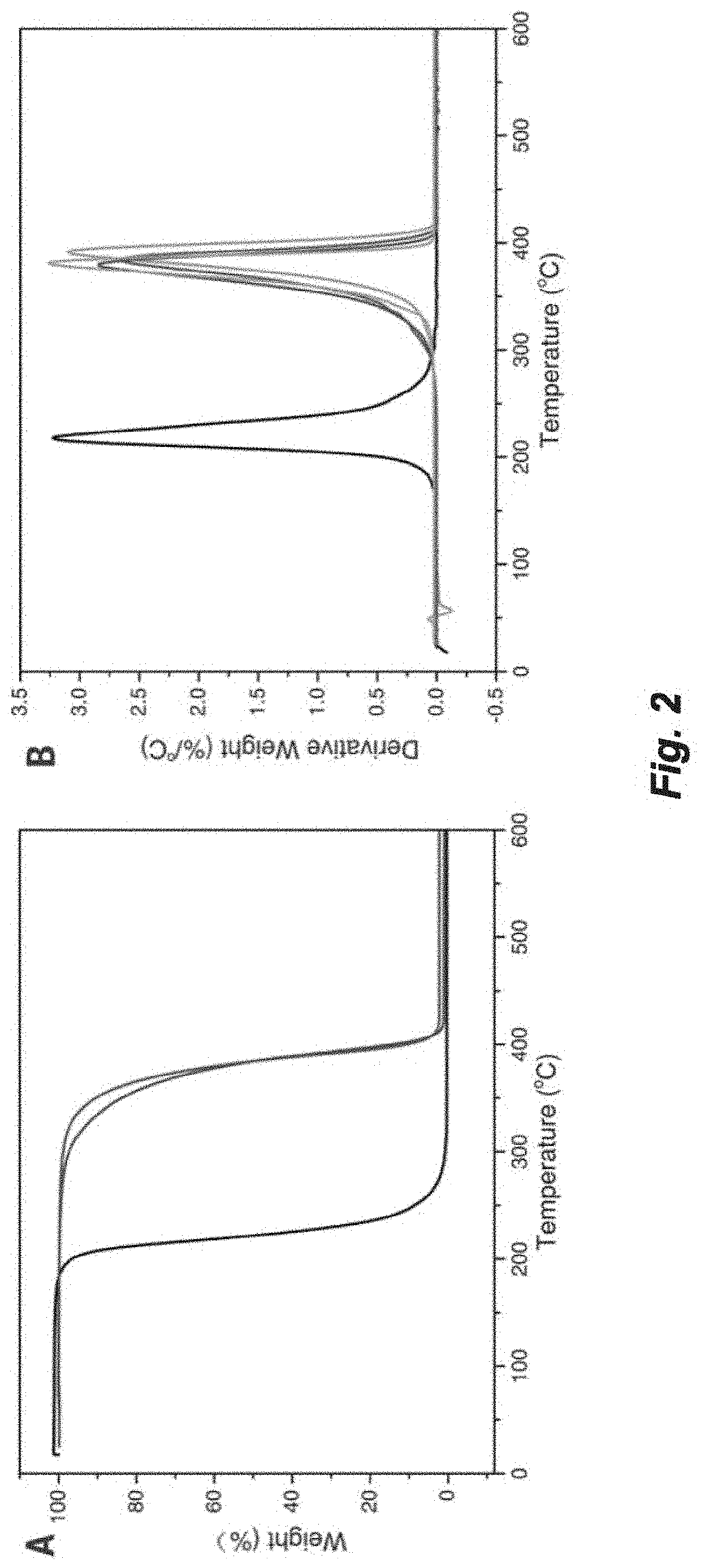Recyclable polymers based on ring-fused gamma-butyrolactones
a technology of gammabutyrolactone and polymer, which is applied in the field of ring-fused gammabutyrolactone-based cyclable polymers, can solve the problems of unintended environmental consequences, failure to recover valuable building block chemicals, and general failure to address the end-of-use problems of materials using renewable resources as feedstock materials, etc., to achieve quantitative recyclability, robust thermal stability and mechanical strength, and convenient production
- Summary
- Abstract
- Description
- Claims
- Application Information
AI Technical Summary
Benefits of technology
Problems solved by technology
Method used
Image
Examples
example 1
of Monomers
Materials and Methods
[0172]All syntheses and manipulations of air- and moisture-sensitive materials were carried out in flamed Schlenk-type glassware on a dual-manifold Schlenk line, on a high-vacuum line, or in an inert gas (Ar or N2)-filled glovebox. High-performance liquid chromatography (HPLC)-grade organic solvents were first sparged extensively with nitrogen during filling 20 L solvent reservoirs and then dried by passage through activated alumina (for diethyl ether, tetrahydrofuran, and dichloromethane) followed by passage through Q-5 supported copper catalyst (for toluene and hexanes) stainless steel columns. HPLC-grade N,N-dimethylformamide (DMF) was degassed and dried over CaH2 overnight, followed by vacuum distillation (CaH2 was removed before distillation). Toluene-ds was dried over sodium / potassium alloy and vacuum-distilled or filtered, whereas CD2Cl2 and CDCl3 were distilled over CaH2 and then stored over activated Davison 4 Å molecular sieves.
[0173]All mon...
example 2
amic Studies
[0221]In a glovebox under an argon atmosphere, an NMR tube was charged with Y1 (7.4 mg, 9.8 μmol), and 0.3 mL of toluene-ds. The NMR tube was sealed with a Precision Seal rubber septum cap and taken out of the glovebox and immersed in a cooling bath at −78° C. After equilibration at −78° C. for 10 min, M1 (68.7 mg, 0.49 mmol, [M1] / [Y1]=50 / 1) in toluene-ds (0.4 mL) was added via a gastight syringe and the NMR tube was brought into a 500 MHz NMR probe precooled to the desired polymerization temperature (−25, −30, −35 and −40° C., respectively). The conversion of the monomer was monitored by 1H NMR at different time intervals until the conversion remained constant at each temperature. Worth noting here is that the isomerization to the non-polymerizable cis-isomer was less than 3% under the low temperatures.
[0222]The equilibrium monomer concentration, [M1]eq, obtained by plotting [M1] as a function time until the monomer concentration reached a constant, was measured to be 0...
example 3
olymerization Procedures
[0223]Polymerizations were performed in 5 mL glass reactors inside the glovebox for ambient temperature (˜25° C.) runs, or in 25 mL Schlenk flasks interfaced to a dual-manifold Schlenk line with an external temperature bath for runs at other temperatures. In a typical polymerization reaction, catalyst was added to the vigorously stirred monomer. After a desired period of time, the polymerization was quenched by addition of 3 mL HCCl3 acidified with HCl (5%). The quenched mixture was precipitated into 100 mL of cold methanol, filtered, washed with methanol to remove any unreacted monomer, and dried in a vacuum oven at 50° C. to a constant weight (see Table 3 and FIGS. 5-12).
PUM
| Property | Measurement | Unit |
|---|---|---|
| polydispersity index | aaaaa | aaaaa |
| temperature | aaaaa | aaaaa |
| pressure | aaaaa | aaaaa |
Abstract
Description
Claims
Application Information
 Login to View More
Login to View More - R&D
- Intellectual Property
- Life Sciences
- Materials
- Tech Scout
- Unparalleled Data Quality
- Higher Quality Content
- 60% Fewer Hallucinations
Browse by: Latest US Patents, China's latest patents, Technical Efficacy Thesaurus, Application Domain, Technology Topic, Popular Technical Reports.
© 2025 PatSnap. All rights reserved.Legal|Privacy policy|Modern Slavery Act Transparency Statement|Sitemap|About US| Contact US: help@patsnap.com



